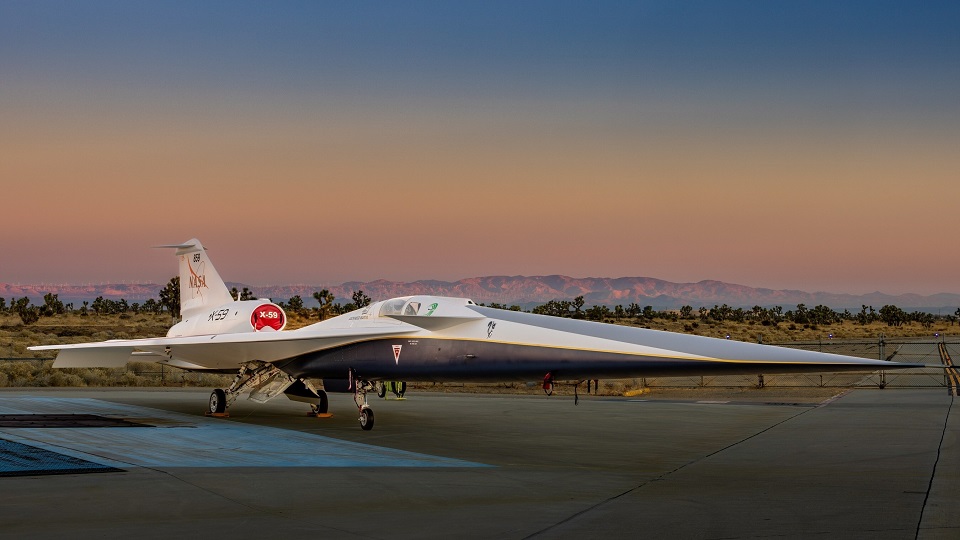Aerospace
NASA, Lockheed Martin Reveal X-59 Quiet Supersonic Aircraft

The X-59 quiet supersonic aircraft, developed by NASA and Lockheed Martin, made its official debut on Friday.
NASA hopes to collect data from this unique experimental aircraft that could transform air travel and lead to the development of a new class of commercial aircraft capable of exceeding the speed of sound.
NASA’s Quest mission, which aims to provide information to assist regulators in reconsidering regulations that forbid commercial supersonic flight over land, is centered around the X-59. Due to the disruptive effects of the loud, unexpected sonic booms on the nearby communities, the United States and other countries have prohibited these flights for the past fifty years.
It is anticipated that the X-59 will travel at 925 mph, or 1.4 times the speed of sound. The aircraft’s shape, design, and technologies will enable it to reach these speeds with a less audible thud. After the rollout is finished, the Quesst team will move on to integrated systems testing, engine runs, and X-59 taxi testing to get ready for the aircraft’s first flight.
Later this year, the aircraft is scheduled to make its first flight—a silent supersonic journey—after taking off for the first time. Before transferring the aircraft to NASA’s Armstrong Flight Research Centre in Edwards, California, which will serve as its base of operations, the Quesst team will carry out a number of the aircraft’s flight tests at Skunk Works.
After the flight tests are finished, NASA will fly the aircraft over several future cities in the United States to gather feedback on the sound the X-59 produces and how people hear it. The Federal Aviation Administration and foreign regulators will receive that data from NASA.
The X-59 is an exclusive test aircraft, not a prototype; its technologies are intended to guide the development of quiet supersonic aircraft in the future. The aircraft’s dimensions—99.7 feet long by 29.5 feet wide—along with the innovations it contains will enable silent supersonic travel. Nearly a third of the X-59’s length is made up of its narrow, tapering nose, which helps to disperse the shock waves that would normally cause a supersonic aircraft to produce a sonic boom.
This arrangement results in the cockpit being nearly halfway down the aircraft’s length and lacking a forward-facing window. The eXternal Vision System, on the other hand, was created by the Quesst team and consists of several high-resolution cameras that feed a 4K monitor in the cockpit.

Aerospace
Boeing Transfers Rocket Stage to NASA, Paving Way for Human Moon Mission

Boeing has achieved a significant milestone by providing NASA with the second core stage of the Space Launch System (SLS) rocket.
This crucial component, crafted at NASA’s Michoud Assembly Facility (MAF), is set to propel the Artemis II crew into lunar orbit, marking humanity’s return to deep space after a 50-year hiatus.
The monumental Boeing-built rocket stage, the largest element of the Artemis II mission, will embark on a journey aboard the Pegasus barge, traveling 900 miles to NASA’s Kennedy Space Center.
Comparison of two legendary aircraft B777x vs B747 aircraft:Click here
Upon arrival, it will be meticulously integrated with other essential Artemis II components, including the upper stage, solid rocket boosters, and NASA’s Orion spacecraft within the iconic Vehicle Assembly Building. This intricate integration process is a vital step toward the eagerly anticipated Artemis II launch, slated for 2025.
“Boeing-built products helped land humankind on the moon in 1969, and we’re proud to continue that legacy through the Artemis generation,” remarked Dave Dutcher, vice president and program manager for Boeing’s SLS program. “Together, with NASA and our industry partners and suppliers, we are building the world’s most capable rocket and paving the way to deep space through America’s rocket factory in New Orleans.”
NASA, Lockheed Martin Reveal X-59 Quiet Supersonic Aircraft:Click here
The delivery of Core Stage 2 marks a significant achievement in the evolution of the SLS rocket. Towering over 200 feet and powered by four RS-25 engines, this core stage, coupled with two solid-fueled booster rockets, will generate a staggering 8.8 million pounds of thrust. This immense power is crucial to launching Artemis II and future missions into the vast expanse of space.
The SLS rocket stands unparalleled in its capability to transport both crew and substantial cargo to the moon and beyond in a single launch. Its extraordinary capacity will facilitate the delivery of human-rated spacecraft, habitats, and scientific missions to destinations including the moon and Mars, ushering in a new era of space exploration.
-

 Travel1 week ago
Travel1 week agoAir India to Expand US Operations with Three New Routes After a Decade
-

 Travel2 weeks ago
Travel2 weeks agoWhy We Should Avoid These Stamps in a Passport
-

 Airlines1 month ago
Airlines1 month agoInvestigations Reveal Fake Chinese Titanium in Boeing and Airbus Jets
-

 Tech4 weeks ago
Tech4 weeks agoChina’s CATL Plans 1,800-Mile Electric Plane Launch by 2027
-

 Airport3 days ago
Airport3 days agoTop 10 Largest Airports in the World by Size
-

 Aerospace4 weeks ago
Aerospace4 weeks agoChina’s Fighter Jets Turn Wings into Autonomous Drones
-

 Airlines4 days ago
Airlines4 days agoAir India Rolls Out A350s for Delhi-New York JFK and Newark Routes
-

 Defence3 weeks ago
Defence3 weeks agoBoeing Enhances Chinook with New Engines and Block II Upgrades at $96 Million







